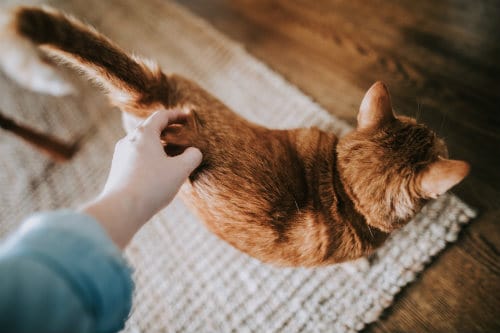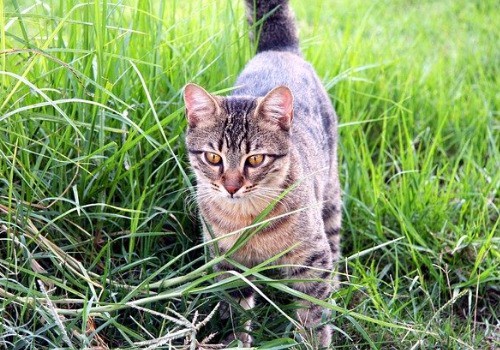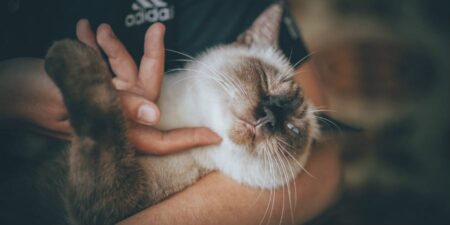With dogs, tail wagging is pretty easy to understand. With cats, however, a twitching or switching tail usually signals excitement, irritation or aggression, or anticipation. In general, while a moving tail indicates heightened emotion of some kind, the more specific meaning will usually come from the rest of your cat’s body language, and not just the tail.
As humans, of course, we can’t really mirror a cat’s body language back at them one hundred percent. However, understanding what your cat is trying to tell you can go a long way towards making sure that you and your cat can have an open communication free of misunderstandings and confusion!
Excitement

Just like dogs, cats can wag their tails to show that they’re happy or excited or just pleased to see you! A cat’s tail is obviously built differently than a dog’s, so the motion isn’t quite the same, but the emotion conveyed can often be very close to the same thing.
[amazon bestseller=” Cats active toy”]
The biggest indication that a wagging tail means excitement lies in the position of the tail itself. If your cat’s tail is sticking straight up and quivering from side to side, that usually means that they’re pretty happy to see you. Cat trainers and psychologists agree that a cat with its tail in this position is happy, content animal.
No matter the tail position, however, the size of the movement can still be a pretty big indicator. If your cat’s tail is straight up, but they’re giving large, “derisive” waves, it can be a show of disdain. If the movements are quick, small, and controlled, it serves as a sign that your cat is pleased or excited about something or someone in the room.
Obviously, there are usually some other indicators if your cat is happy or excited by something. If they’re content, they will most likely be purring or letting their eyes close part of the way. If they’re excited, they may be moving around more than usual, or they may be rubbing up against you, making sure that you notice how happy they are.
The importance of context in trying to guess your cat’s mood cannot be overstated. What may look like a happy, excited cat can easily be misread as a tense or irritated cat, and a lot of it comes down to the context and situation. You know your cat’s moods better than anyone else, so take the time to get used to how they react to various situations.
Irritation or Aggression

As mentioned above, a lot of a cat’s behavior can vary between different circumstances, and tail wagging is no exception. Sometimes what looks like a happy tail quiver can actually be a sign of irritation or discomfort. If this is the case, it’s important to be able to pick up on your cat’s mood before it’s forced to lash out in some other way.
[amazon bestseller=” Cats tree”]
This is another situation where the tail position is a pretty big key. A displeased cat will often hold its tail straight and low, motionless except for quick, sharp movements. If you notice your cat holding their tail this way in a specific situation, try and figure out what about the situation is making them uncomfortable.
Some cats veer away from the straight and stiff pose. Look out also for a tail that’s arched right at the base before curling under towards the legs. Either way, the main takeaway in both poses is that an uncomfortable cat will keep its tail low.
A frightened or aggressive cat, on the other hand, may try to make its tail–and, by extension, the rest of its body–appear larger. Cats that are gearing up for a fight or flight reaction will raise their tails and puff out all the hair. By puffing out the hair like this, they can make their tails seem larger, and present a larger threat to another cat or some other predator.
Just like the happy tail wagging, these tail positions will often be accompanied by other, equally obvious signs of displeasure. A cat that’s annoyed or irritated may narrow its eyes or adopt a slightly angry expression. An angry cat, on the other hand, will often arch its back, lay its ears flat against its head, and let the hair along the spine raise along with the tail.
Finally, an extremely frightened cat will usually tuck its tail between its legs. As in dogs and most other animals with tails, this is a clear way of indicating to a threat that the cat is submissive, or doesn’t want to fight. If you notice your cat displaying any of the body language listed here, it’s usually a pretty good sign that you should get your cat out of the situation as soon as possible.
Anticipation

Probably the most instantly recognizable tail movement common to cats is the steady, back-and-forth swish that indicates a cat is about to pounce. This can be directed at anything from an insect to a toy to an unprotected set of fingers or toes, and usually serves as the only warning you may get before your cat decides it’s time to play!
[amazon bestseller=” Cats automatic toy”]
It’s unknown why, exactly, cats display this smooth, swooshing tail behavior. Some have theorized that it serves as a way of mesmerizing prey before attacking. Others have suggested that it actually functions as a last-minute check, a way of making sure that the ground behind them is clear and solid before they push off in an attack.
If you see your cat shaking their tail in this way, take a second to make sure that the target of their attention isn’t something that they’re not allowed to chew on. If the coast is clear, sit back and watch as your cat prepares to establish its role as the mightiest hunter in your house!
Other

Some other tail movements can include curling the tail around the cat’s body. If the rest of your cat’s body language indicates nervousness, this could be a sign of uneasiness, as the cat is trying to make itself a smaller target and avoid being noticed. However, if your cat is curled up into a ball as it sleeps, and the tail is tucked somewhere around the nose, this is just another sign of how comfy and content your cat is feeling!
Small tail movements combined with signs of pain or distress can also be a sign of injury. Cats are really good at hiding their pain, but sometimes small or seemingly incongruous tail movements can serve as a way of calling attention to themselves and asking for help.
If your cat is asleep, but you notice their tail twitching slightly when you or someone else in the room speaks, that’s a pretty big compliment! It basically means that your cat is acknowledging that you’re speaking, but still feels safe enough to not have to open their eyes and look around.
The final bit of “tail language” that you may notice in happy cats is a quick sort of tail hug. If your cat curls their tail briefly around your leg or arm and then flips it away, it’s usually a sign of affection, and serves as a cat’s way of letting you know how much they appreciate you!
[amazon bestseller=” Cats treats”]
So How Should I React?

Obviously, as humans, we sort of lack the tools necessary to return any body language from cats in the same way. However, watching your cat for mood changes and responding accordingly can help them feel a lot more confident and comfortable around you and your family.
As mentioned above, unusual tail movement can sometimes be a sign of pain or injury. If you suspect this to be the case, do what you can to make sure that your cat is safe and healthy. Taking your cat to the veterinarian’s office as soon as you suspect something to be wrong can go a long way towards nipping any potential disorders in the bud.
If you notice your cat displaying signs of aggression, anxiety, or fear, act immediately. Remove whatever’s stressing your cat out from the immediate environment, if possible. If impossible, then think about moving your cat to a place where they can feel safe and secure without being confronted by the stressful factor.
Similarly, if your cat is displaying signs of irritation at something you’re doing, take that as your cue to stop immediately. If a cat has grown tired or frustrated of being petted and cuddled, they will signal their irritation as loudly as possible. Learning the warning signs and acting quickly can prevent you from getting a cat scratch or bite “out of nowhere.”
Finally, if your cat’s tail is showing that they’re happy, relaxed, or pleased with their general surroundings, go ahead and give yourself a pat on the back. Your cat is comfortable around you and feels safe expressing their pleasure with the little things in the environment like a new toy or a new view from the window or just your safe return from a busy day at work!
Conclusion
Cat tail wagging can be a lot more complicated than a dog’s tail wagging. However, their behaviors still fall into the same basic categories as any other animal’s–happy, sad, scared, angry, or excited.
Learning the meaning specific to each different tail movement can take some time, and you may sometimes feel like there are too many variations to count for. However, your cat’s behavior is something that you understand better than anyone else, and eventually, you’ll be able to interpret your cat’s different moods and act accordingly to communicate with them.
"In ancient times cats were worshipped as gods; they have not forgotten this."
-- Terry Pratchett





